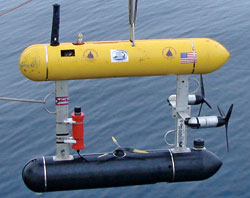 |
 Enlarge image
Enlarge image |
| The SeaBED autonomous underwater vehicle (above) provided high-resolution images of the groundfish habitats (below) off Oregon and Washington, to help assess areas proposed for protection.
|
| |
| Related Links |
» Hanumant Singh's Web site
|
In 1996, Congress passed the Sustainable Fisheries Act, calling
for direct action to stop or reverse the continued loss of
habitats that fish need to spawn, breed, feed, or grow to
maturity. To protect essential fish habitats, you first need
to identify them. Therein lies the challenge: how to see through
the oceans to find out what’s down there?
To assess the abundance and habitats of groundfish such as
rockfish, haike, cod, flatfish, and petrali, the NOAA National
Marine Fisheries Service (NMFS) has relied on bottom trawling.
That method isn’t precise and has obvious disadvantages,
especially in the rocky seafloor habitats preferred by groundfish.
Sonar doesn’t work well because it can’t easily
distinguish fish that bury themselves among rocks.
So NMFS tested an alternative. In 2005, it brought SeaBED,
the underwater autonomous vehicle (AUV) developed at WHOI
by Hanu Singh and colleagues, to survey seafloor areas proposed
for protection off the coasts of Oregon and California.
SeaBED provided high-quality photomosiacs of groundfish habitats
(below), giving scientists the ability not only to identify
particular species but also to assess their relationships
with invertebrates in the ecosystem, said Elizabeth Clarke,
director of the NMFS Fishery Resource Analysis and Monitoring
Division. Maintaining a constant altitude above the seafloor,
SeaBED works well in near-bottom missions and maintains a
consistent field of view, which is important for quantitative
estimates of fish abundances, she said. The AUV is also cost-effective,
because it can cover a 5-to-10-kilometer (3-to-6-mile) transect
on a typical six-hour dive, and once SeaBED is deployed from
a research vessel, the ship can go off and do simultaneous
work to assess habitats.
“We think autonomous underwater vehicles have a lot
of potential,” Clarke said. So SeaBED will be back for
another test in May 2006, this time equipped with a forward-looking
(rather than a sideview) camera to improve fish identifications.
—Lonny Lippsett
 Photomosiacs of groundfish habitats.
Photomosiacs of groundfish habitats.
» View more
highlights for the Applied Ocean Physics and Engineering Department
|

